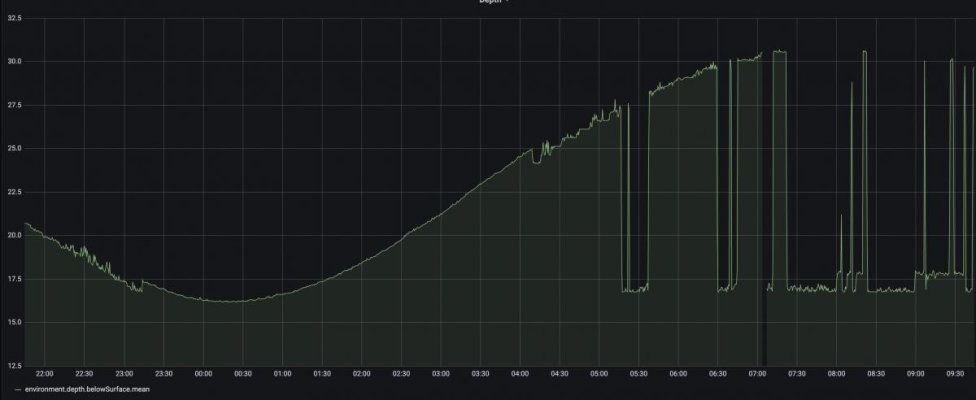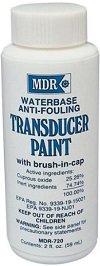twistedtree
Guru
I've read a lot about people having failures with Airmar DST800 depth/temp/speed sounders. Me included. I'm on my second - and last - failure now. Just go read TheHullTruth or CruisersForum and you will see that a lot of people have experience failures on these devices.
These are thruhull transducers that connect directly to NMEA 2000 and, depending on the model transducer, provide depth, temp and speed thru water.
My first - a depth + temp model - started reading crazy water temps after maybe 2 years, and just out of warranty. When I hauled out last December (about a year ago), I replaced it to the tune of about $500.
The replacement included speed in addition to depth and temp. It only cost a little bit more, so I figured what the heck. The speed has never worked properly. It ready about 50% faster than I am actually moving. One might think it's simple calibration process to fix that, but not so. Maretron has a calibration capability, but it didn't work. I then noticed that it disappeared in their next software release. Airmar has a tool, but it doesn't let you adjust speed. I am told that other vendor's displays have an adjustment feature, but I don't want to buy a several hundred dollar display just to calibrate (hopefully) a transducer that is supposed to operate as a stand alone device. So for the past year I have just ignored the speed reading that I paid extra for.
A week ago I got back on the boat, and noticed that there was no temp reading. Some investigation showed the DST800 reporting blank data in the N2K messages that it sends, so clearly a faulty transducer.
I talked to Airmar - actually Gemeco who provide all their support - and they will consider replacing it under warranty, but need me to return it so they can test it first. To return it, I need to pull it out of the thruhull flange, spraying salt water all over my engine room, and install a plug. Then, once they have agreed that it's failed, ship me a new one in Mexico (good luck with that), where I can once again flood my engine room with salt water. And I get to do that to replace a device that by all experience will just fail again.
To limit the salt water shower to one rather than two, I purchased a new DST800 on agreement that I would be credited full price if the warranty return was approved, so I did that, including overnight shipping because I'm about to leave.
It arrived this morning, but the more I thought about salt water spraying all over my engine room and dousing all sorts of stuff, I said No. This just isn't worth it. I'll eat the cost of the device since I will lose my warranty claim, and deal with it at the next haul out. And at that time I'll replace it with something else that is more reliable. The replacement that I bought in advance is getting returned today. Fool me once, shame on you. Fool me twice, shame on me. The DST800 now goes on the wall of shame.
My experience with Airmar transducers has been quite good, except for this one. I suppose that's a good thing since they are the only game in town and make the transducers for everyone. I don't know of any other vendor. But the DST800 is a POS.
These are thruhull transducers that connect directly to NMEA 2000 and, depending on the model transducer, provide depth, temp and speed thru water.
My first - a depth + temp model - started reading crazy water temps after maybe 2 years, and just out of warranty. When I hauled out last December (about a year ago), I replaced it to the tune of about $500.
The replacement included speed in addition to depth and temp. It only cost a little bit more, so I figured what the heck. The speed has never worked properly. It ready about 50% faster than I am actually moving. One might think it's simple calibration process to fix that, but not so. Maretron has a calibration capability, but it didn't work. I then noticed that it disappeared in their next software release. Airmar has a tool, but it doesn't let you adjust speed. I am told that other vendor's displays have an adjustment feature, but I don't want to buy a several hundred dollar display just to calibrate (hopefully) a transducer that is supposed to operate as a stand alone device. So for the past year I have just ignored the speed reading that I paid extra for.
A week ago I got back on the boat, and noticed that there was no temp reading. Some investigation showed the DST800 reporting blank data in the N2K messages that it sends, so clearly a faulty transducer.
I talked to Airmar - actually Gemeco who provide all their support - and they will consider replacing it under warranty, but need me to return it so they can test it first. To return it, I need to pull it out of the thruhull flange, spraying salt water all over my engine room, and install a plug. Then, once they have agreed that it's failed, ship me a new one in Mexico (good luck with that), where I can once again flood my engine room with salt water. And I get to do that to replace a device that by all experience will just fail again.
To limit the salt water shower to one rather than two, I purchased a new DST800 on agreement that I would be credited full price if the warranty return was approved, so I did that, including overnight shipping because I'm about to leave.
It arrived this morning, but the more I thought about salt water spraying all over my engine room and dousing all sorts of stuff, I said No. This just isn't worth it. I'll eat the cost of the device since I will lose my warranty claim, and deal with it at the next haul out. And at that time I'll replace it with something else that is more reliable. The replacement that I bought in advance is getting returned today. Fool me once, shame on you. Fool me twice, shame on me. The DST800 now goes on the wall of shame.
My experience with Airmar transducers has been quite good, except for this one. I suppose that's a good thing since they are the only game in town and make the transducers for everyone. I don't know of any other vendor. But the DST800 is a POS.


